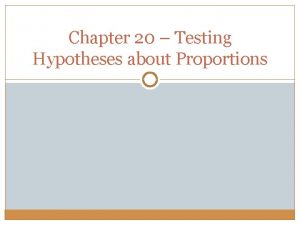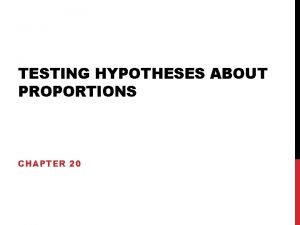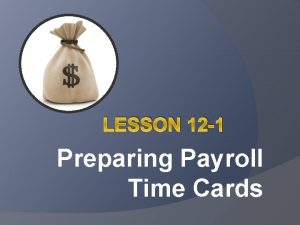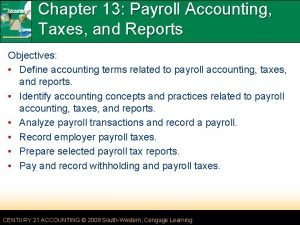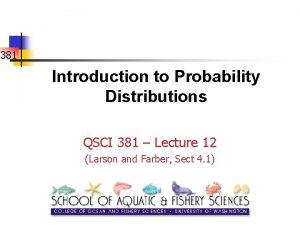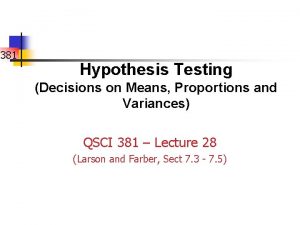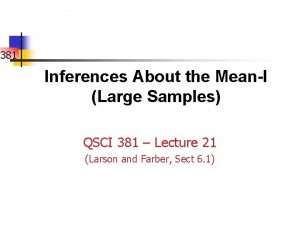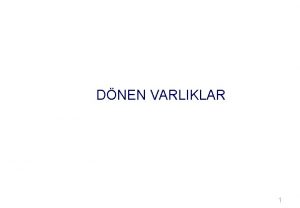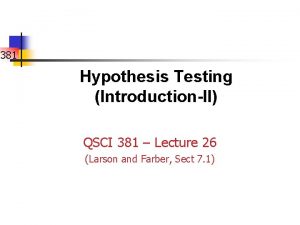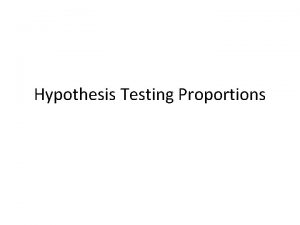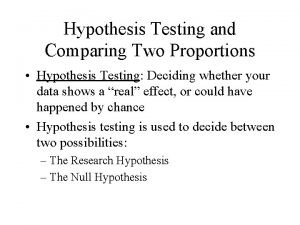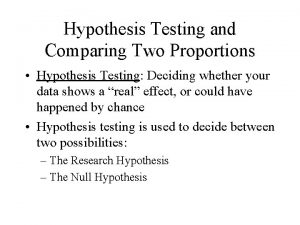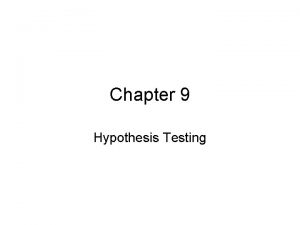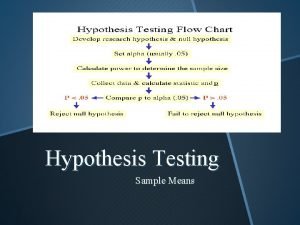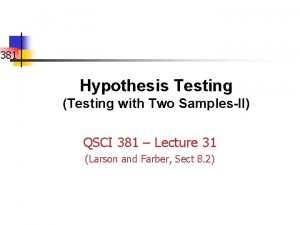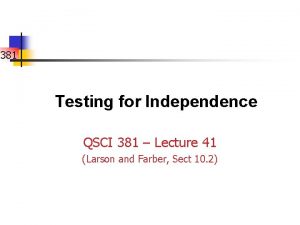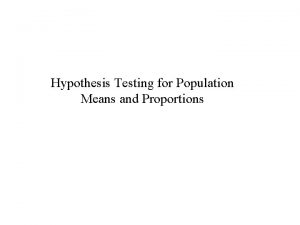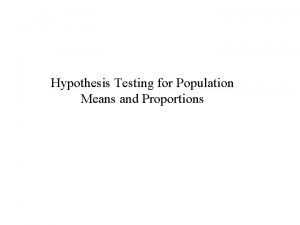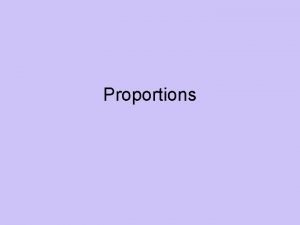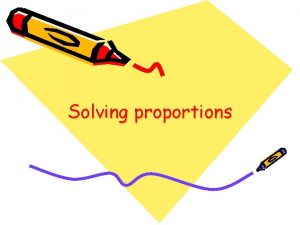381 Hypothesis Testing Decisions on Means Proportions and
















- Slides: 16

381 Hypothesis Testing (Decisions on Means, Proportions and Variances) QSCI 381 – Lecture 28 (Larson and Farber, Sect 7. 3 - 7. 5)

Overview 381 n n Yesterday, we dealt with the case in which the sample size was “large”. Today we address the issue of how to handle cases in which the sample size is “small”. By “small” we mean less than 30 samples – note that the population needs to be normal (or at least approximately normal).

The Test Procedure 381 4. State the claim mathematically and verbally. Identify the null and alternative hypotheses. H 0 = ? ; Ha = ? Specify the level of significance. =? Identify the degrees of freedom (d. f = n-1) and hence the critical value(s) and the rejection region. Determine the standardized test statistic: 5. Check whether t is in the rejection region. 1. 2. 3.

Example-I (Comparison of Treatments) 381 n n Under normal feeding conditions, a given fish is 2 kg after two years of growth. We develop an alternative feeding program (which is cheaper). We feed a sample of 20 fish and, after 2 years, the fish are 1. 9 kg on average (s. d. 0. 4). Can someone reject the claim that fish fed on our diet are greater or equal to those fed using the usual diet.

Example-II 381 1. 2. 3. 4. 5. H 0: 2; Ha: <2. Note that We multiply by 2 =0. 05. d. f = 19; tc=-1. 73 (TINV(2*0. 05, 20 -1)) t = (1. 9 -2)/(0. 4/ 20)=-1. 11 t is not in the rejection region (even though the sample mean is less than the value we are comparing it with).

381 Example-III Rejection region Do not reject What would have happened had our standard deviation been 0. 2 rather than 0. 4? Just because we cannot reject the null hypothesis does not mean that it is not false!

Hypothesis Tests for Proportions-I 381 n n Recall that we can approximate a binomial distribution, B(n, p) with the normal distribution, as long as np 5, nq 5. We will make use of this to define a hypothesis test for proportions.

Hypothesis Tests for Proportions-II 381 3. State the claim mathematically and verbally. Identify the null and alternative hypotheses. H 0 = ? ; Ha = ? Specify the level of significance, , and hence the rejection region. Determine the standardized test statistic: 4. Check whether z is in the rejection region 1. 2.

Example-I 381 n n Under the Sustainable Fisheries Act, stocks should be managed so that they are at a target level. The expectation is therefore that 50% of stocks are above their target levels. We review the status of 300 stocks and find that 47% (a slight exaggeration of reality) are below their target levels. Can we reject the claim that management is achieving it’s goal? Use a significance level of 0. 01.

Example-II 381 1. H 0: p 0. 5; Ha: p>0. 5. 3. =0. 01. The rejection region is z > 2. 33. The standardized test statistic is: 4. We fail to reject H 0. 2. The U. S. government supplies statistics on its performance managing fisheries*. See if its performance is really as good as this? ? * http: //www. nmfs. noaa. gov/sfa/statusoffisheries/SOSmain. htm

Hypothesis Tests for Variances-I (the 2 test) 381 1. 2. 3. 4. State the claim mathematically and verbally. Identify the null and alternative hypotheses. H 0 = ? ; Ha = ? Specify the level of significance, , and determine the degrees of freedom (d. f. = n-1) Find the rejection region (note that the chi-square distribution is not symmetric) Determine the standardized test statistic: Check whether 2 is in the rejection region. Note that the population must be normally distributed to use this test.

Hypothesis Tests for Variances-II (Finding the critical values and the rejection region) 381 n We need: n n n The level of significance. The degrees of freedom Whether this is a: n n n right-tailed test ( 2 corresponding to ) left-tailed test ( 2 corresponding to 1 - ) two-tailed test ( 2 corresponding to ½ and 1½ )

Hypothesis Tests for Variances-III (Finding the critical values and the rejection region) 381 n Given n=26 (i. e. d. f=25). Find the rejection regions for =0. 1: =CHIINV(0. 9, 25) =CHIINV(0. 1, 25) =CHIINV(0. 05, 25) =CHIINV(0. 95, 25)

Example-I 381 n A restaurant claims that the standard deviation of the length of its serving times is less than 2. 9 minutes. A random sample of 23 serving times has a standard deviation of 2. 1 minutes. Is there enough evidence to support the claim at the 0. 1 level of significance?

Example-II 381 4. The null hypothesis is 2. 9 (not <2. 9 – why). The level of significance is 0. 1 and degrees of freedom is 22 (23 -1). This is left-tailed test so we determine the critical value of 2 to be 14. 042 (=CHIINV(0. 9, 22)). We now calculate the standardized test statistic: 5. Now 11. 54 < 14. 042 so we reject H 0. 1. 2. 3.

Caveats About Hypothesis Testing 381 n Check the assumptions of the test: n n Random sampling Must the population be normal? Not rejecting the null hypothesis is not the same as proving it to be true. We should never say that the null hypothesis is proven if the p-value . Hypothesis tests focus on Type I error, but never forget about type II error.
 Meaning of poster making
Meaning of poster making Screening decisions and preference decisions
Screening decisions and preference decisions Ratio and proportion for use after section 7-2
Ratio and proportion for use after section 7-2 Chapter 20 testing hypotheses about proportions
Chapter 20 testing hypotheses about proportions Chapter 19 testing hypotheses about proportions
Chapter 19 testing hypotheses about proportions Chapter 20 testing hypotheses about proportions
Chapter 20 testing hypotheses about proportions Research hypothesis example
Research hypothesis example Alternative hypothesis
Alternative hypothesis Protoplanet hypothesis weakness
Protoplanet hypothesis weakness 13-1 work together p. 381
13-1 work together p. 381 1. 13-1 work together, p. 381
1. 13-1 work together, p. 381 381 meaning
381 meaning 381 meaning
381 meaning 381 meaning
381 meaning S 381
S 381 Dönem ayırıcı hesaplar nedir
Dönem ayırıcı hesaplar nedir Dönem ayirici hesaplar 180 181 280 281 380 381
Dönem ayirici hesaplar 180 181 280 281 380 381



